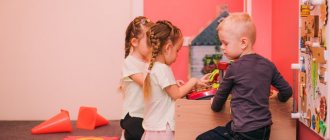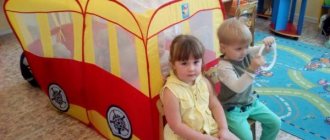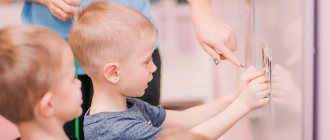Communication games 5-7 years
Communication games
From 5 to 7 years
Siamese twins
Goal: development of communication skills, the ability to coordinate one’s actions, development of graphic skills.
Age: 6-7 years.
Number of players: multiple of two.
Necessary equipment: dressing bandage (scarf), large sheet of paper, wax crayons.
Description of the game: children are divided into pairs, sit at the table very close to each other, then tie the right hand of one child and the left hand of the other from elbow to hand. Each person is given a piece of chalk. Crayons should be different colors. Before starting to draw, children can agree among themselves what they will draw. Drawing time: 5-6 minutes. To complicate the task, one of the players can be blindfolded, then the “sighted” player must direct the movements of the “blind” one.
Palm to palm
Goal: developing communication skills, gaining experience interacting in pairs, overcoming the fear of tactile contact.
Age: any.
Number of players: 2 or more people.
Necessary equipment: table, chairs, etc.
Description of the game: children stand in pairs, pressing their right palm to their left palm and their left palm to their friend’s right palm. Connected in this way, they must move around the room, avoiding various obstacles: a table, chairs, a bed, a mountain (in the form of a pile of pillows), a river (in the form of a laid out towel or a children's railway), etc.
Path
Goal: developing the ability to act together as a team.
Age: 6-7 years.
Hold hands. On the command “walk” - walk in a circle;
“Path” - children put their hands on the shoulders of the person in front and tilt their heads down;
“Kopna” - children raise their arms above their heads;
“Bumps!” - everyone crouches.
I can speak very quietly. Which team will be the most attentive?
Skyscraper
Goal: developing the ability to negotiate and work in a team.
Age: 6-7 years.
Number of players: 5-6 people.
Necessary equipment: folding meter; 2-3 wooden cubes (can be of different sizes) for each child.
Description of the game: children sit in a circle, and in the center of the circle they need to build a skyscraper. Children take turns placing their cubes (one at a time). At the same time, they can discuss where it is better to put the cube so that the skyscraper does not fall. If at least one cube falls, construction begins again. An adult observing the progress of construction periodically measures the height of the building.
KIND ANIMAL
Goal: to promote the unity of the children's team, teach children to understand the feelings of others, provide support and empathy.
The presenter says in a quiet, mysterious voice: “Please stand in a circle and hold hands. We are one big, kind animal. Let's listen to how it breathes! Now let's breathe together! When you inhale, take a step forward; when you exhale, you take a step back. Now, when you inhale, take two steps forward, and when you exhale, take two steps back. Inhale - two steps forward. Exhale - take two steps back. This is how the animal not only breathes, its big, kind heart beats just as clearly and evenly. A knock is a step forward, a knock is a step back, etc. We all take the breath and heartbeat of this animal for ourselves.”
THE DRAGON
Goal: to help children with communication difficulties gain confidence and feel like part of a team.
The players stand in a line, holding each other's shoulders. The first participant is the “head”, the last one is the “tail”. The “head” should reach out to the “tail” and touch it. The dragon's "body" is inseparable. Once the "head" grabs the "tail", it becomes the "tail". The game continues until each participant plays two roles.
FOLD THE PICTURE
Goal: to develop children's ability to cooperate.
To complete this exercise, you need several pictures of animals, cut into 3-4 parts (head, legs, body, tail), for example, a dog, a cat. Children are divided into groups of 3-4 people. Each group member receives a piece of his picture. The group needs to “put the picture together,” that is, each group member needs to depict their own piece so that the result is a whole animal.
SNAIL
Goal: development of endurance and self-control.
Description of the game: children stand in one line and, at a signal, begin to slowly move towards a pre-agreed place, and they cannot stop and turn around. The last one to reach the finish line wins.
Comment: To follow the rules of this game, preschool children need to put in a lot of effort, as they are active and mobile.
It is especially useful to include this game in the work of groups in which conflict-ridden, aggressive children participate. It can also be used in working with hyperactive children, but only at the last stages of correction.
CROCODILE
Goal: development of dexterity, observation, removal of fears.
Game description: children choose a “crocodile”. The chosen one stretches his arms forward, one above the other - this is the crocodile's mouth - and walks around the room (platform), singing songs, dancing, jumping. Meanwhile, the children put their hands in their mouths. At some point, the “crocodile” closes its mouth. Whoever did not have time to pull his hand out becomes a “crocodile”.
Comment: as many children as possible should play the role of a “crocodile” in order to feel the change in role sensations.
CHANGERS
Target. Develop communication skills and activate children.
The game is played in a circle. Participants choose a driver - he takes his chair out of the circle. It turns out that there are one fewer chairs than there are players. Then the presenter says: “Those who have ... (blonde hair, watches, etc.) change places.” After this, those with the named sign quickly get up and change places, and the driver tries to take an empty seat. The participant in the game who is left without a chair becomes the driver.
TRAFFIC PROHIBITED
Target. Teach games with clear rules that organize, discipline, unite, develop speed of reaction and cause emotional uplift.
Children stand facing the leader. To the music, at the beginning of each measure, they repeat the movements shown by the presenter. Then a movement is selected that cannot be performed. Anyone who violates this prohibition leaves the game. Instead of showing the movement, you can say the numbers out loud. The participants in the game repeat all the numbers in chorus, except for one that is forbidden, for example the number 5. When the children hear it, they will have to clap their hands (or spin around in place).
LISTEN TO THE CLAPS
Target. Train attention and control of motor activity.
Everyone walks in a circle or moves around the room in a free direction. When the leader claps his hands once, the children should stop and take the stork pose (stand on one leg, arms to the sides) or some other pose. If the leader claps twice, the players should take the frog position (squat, heels together, toes and knees to the sides, hands between the feet on the floor). After three claps, the players resume walking.
COMPLIMENT
Children sit in a circle. Each participant says to the neighbor on the right (or left) a phrase that begins with the words: “I like about you...”. The exercise helps the child see his positive sides and feel accepted by other children.
Wish
Goal: to cultivate interest in a communication partner.
Children sit in a circle and, passing a ball (“magic wand” or other), express wishes to each other. For example: “I wish you a good mood”, “Always be as brave (kind, beautiful...) as you are now”, etc.
Give a gift
Goal: to introduce children to nonverbal methods of communication.
The teacher depicts various objects using gestures and expressive movements. The one who guesses correctly receives this item “as a gift”. Then the presenter invites the children to make a gift for each other.
The day comes, everything comes to life.
Goal: to develop expressive postures in children, to teach them to be attentive.
The presenter pronounces the first half of the opening, all participants begin to move around the room in a chaotic order. When the presenter pronounces the second half of the opening, everyone freezes in bizarre poses. Then, at the choice of the presenter, individual participants “die off” and justify the pose in an invented way.
Blackbirds
Goal: develop communication skills, cultivate a friendly attitude towards peers.
Children are divided into pairs and repeat the words and actions after the teacher:
I'm a thrush. (Point to themselves.)
And you are a blackbird. (Point to their partner.) I have a nose. (They touch their nose.)
You have a nose. (They touch their partner’s nose.)
My lips are sweet. (They touch their lips.)
Your lips are sweet. (They touch their partner’s lips.)
My cheeks are smooth. (Stroke their cheeks.)
Your cheeks are smooth. (They stroke their partner’s cheeks.)
“Let's join hands, friends”
Goal: to teach children to feel the touch of another person. The teacher and children stand in a circle, at a short distance from each other, with their arms along their torso. You need to hold hands, but not immediately, but one by one. The teacher begins. He offers his hand to the child standing next to him. And only after the child feels the adult’s hand does he give his free hand to his neighbor. Gradually the circle closes.
Drawing on the back
Goal: to develop skin sensitivity and the ability to distinguish tactile images.
Children are divided into pairs. One child gets up first, the other follows him. The player standing behind draws an image (a house, a sun, a Christmas tree, a ladder, a flower, a boat, a snowman, etc.) on the partner’s back with his index finger. The partner must determine what is drawn. Then the children change places.
“Stream”
Goal: to help children get in touch and make emotionally significant choices.
Children are randomly divided into pairs. Couples sit behind each other, holding hands and raising their clasped hands up. The one who does not have enough pair passes under the closed hands and chooses a partner. The new couple stands behind, and the freed participant in the game enters the stream and looks for a couple, etc.
Find a friend (for children from 5 years old)
The exercise is performed among children or between parents and children. One half is blindfolded, given the opportunity to walk around the room and asked to find and recognize a friend (or their parent). You can find out with your hands, feeling your hair, clothes, hands. Then, when a friend is found, the players switch roles.
"The wind blows on." (for children 5-10 years old)
With the words "The wind blows on." The host starts the game. In order for the participants in the game to learn more about each other, the questions could be as follows: “The wind blows on the one with blond hair,” all the blond ones gather in one pile. “The wind blows on the one who has it. has a sister”, “who loves animals”, “who cries a lot”, “who has no friends”, etc.
The presenter must be changed, giving each participant the opportunity to ask questions.
Secret (for children from 6 years old)
The presenter gives each participant a “secret” from a beautiful chest (a button, a bead, a brooch, an old watch, etc.), puts it in his palm and clasps his fist. Participants walk around the room and, fueled by curiosity, find ways to persuade everyone to show him their secret.
Mittens (for children from 5 years old)
To play, you need mittens cut out of paper; the number of pairs is equal to the number of pairs of participants in the game. The presenter throws mittens with the same ornament, but not painted, around the room. The children scatter around the hall. They find their “pair,” go to a corner and, using three pencils of different colors, try to color the mittens exactly the same as quickly as possible.
Note: The facilitator observes how the couples organize their work together, how they share pencils and how they negotiate. The winners are congratulated.
Touch it. (for children from 5 years old)
All players are dressed differently. The presenter shouts: “Touch it.” blue! Everyone must instantly orient themselves, find something blue in the participants’ clothes and touch this color. The colors change periodically; those who didn’t have time are the presenter.
Note: An adult ensures that each participant is touched.
Shadow (for children from 5 years old)
One player walks around the room and makes different movements, unexpected turns, squats, bends to the sides, nods his head, waves his arms, etc. Everyone else stands in a line behind him at a short distance. They are his shadow and must quickly and clearly repeat his movements. Then the leader changes.
Broken phone
Age: from 5 years
Children in a chain pass a word into each other's ears. The latter must say this word out loud. Then the guys figure out what word they were supposed to convey, where the “telephone” went bad.
Tsarevna-Nesmeyana
Age: from 5 years
The players are divided into two teams.
The members of the first team of “Princess Nesmeyana” sit on chairs and take on a serious or sad look.
The members of the other team, the “mixers,” take turns or together must make “Nesmeyan” laugh.
Each “Nesmeyana” who smiles leaves the game or joins the team of “mixers”.
If within a certain period of time it is possible to make all the “Nesmeyans” laugh, the team of “mixers” is declared the winner; if not, the “Nesmeyan” team is declared the winner.
After the winners are announced, teams can switch roles.
Exercise Fun Counting
Goal: relieving the internal tension of the participants, uniting the group by jointly and simultaneously performing the exercise.
Age: from 5 years
Progress of the exercise: The leader names a number not exceeding the number of people in the group. The named number of participants stands up. In performing the exercise, it is necessary to achieve synchronicity; participants should not deliberate.
Psychological meaning of the exercise: the exercise allows participants to feel another, understand his thoughts in order to more effectively complete the task.
Discussion: Why couldn’t you complete the task at first? What helped you complete the task?
Exercise Who is faster?
Goal: team building.
Age: from 5 years
Progress of the exercise: The group must quickly, without words, build the following figures using all the team players:
square; triangle; rhombus; letter; school of birds.
The psychological meaning of the exercise: coordination of joint actions, distribution of roles in the group.
Pyramid of Love
Goal: to cultivate a respectful, caring attitude towards the world and people; develop communication skills.
Age: 5-7 years.
Procedure: children sit in a circle. The teacher says: “Each of us loves something or someone; We all have this feeling, and we all express it differently. I love my family, my children, my home, my city, my work. Tell us who and what you love. (Children's stories.) Now let's build a “pyramid of love” from our hands. I will name something I love and put my hand, then each of you will name your favorite and put your hand. (Children build a pyramid.) Do you feel the warmth of your hands? Do you enjoy this state? Look how tall our pyramid is. High, because we are loved and love ourselves.”
Wizards
Age: 5-7 years.
Goal: continue to cultivate a friendly attitude towards each other, the ability to show attention and care.
Progress: children are asked to imagine that they are magicians and can make their own wishes and the wishes of others come true. For example, we will add courage to Volodya, agility to Alyosha, etc.
Game with spinning top
Goal: Developing the ability to collaborate.
The players sit on the floor in a circle. One child goes to the middle of the circle, spins the spinning top, calls the name of another child, and returns to the circle. The one he named must have time to touch the spinning top while it is spinning. Spins it again and names the next player. Whoever did not have time to run to the top and pick it up is eliminated from the game.
Cold - hot, right - left
Age: 5-7 years
The teacher hides a conditional object (toy), and then, using commands like “Step right, two steps forward, three left,” leads the player to the goal, helping him with the words “warm,” “hot,” “cold.” When children learn to navigate in space using verbal instructions from an adult, they can use the verbal instructions of another child.
Chain of words
Goal: development of auditory perception.
Age: 5-7 years
The driver is selected. He comes up with and names three to five words, then points to any player who must repeat the words in the same sequence. If the child copes with the task, he becomes a driver.
Pack your suitcase
Goal: development of auditory perception.
Age: 5-7 years
Children are invited to go on a trip. What is needed for that?
Pack things in a suitcase: “Think: what do you need to take with you on the road?” The first traveler names one object, the second repeats and names his own object. The third repeats what the second traveler named and names his own. Etc. Condition: cannot be repeated.
Echo
Goal: development of auditory perception.
Age: 5-7 years
1st option. A poem is read to the children and they repeat the last word of each line.
2nd option. Children are divided into two teams: “Echo” and “Inventors”.
The “inventors” agree on who will say what word on a certain topic, take turns pronouncing the hidden words and asking the players: “What word did Kolya say? Sasha? Etc.".
Mutual citation
Goal: development of auditory perception.
Age: 5-7 years
“We will play this game. I will knock my palms on my knees twice and say my name twice, then clap my hands in the air, calling the name of one of you, for example, “Vanya - Vanya.” Vanya will first knock on his knees twice, calling himself, and then clap his hands and call someone else, for example, “Katya-Katya.” Then Katya, taking over the move, will do the same. Etc. It is important not to look at the participant you are calling, but to pronounce his name into space, looking, for example, in the other direction or at the ceiling.
Chest
Goal: teach children to ask open and closed questions
Age: 5-7 years
There is a chest on the table containing some object. They call one child, he looks into the chest. The other children ask him questions about color, shape, quality,
properties, etc. of this item until they guess what is in the chest.
Rule: All questions must be answered only “Yes” or “No”.
Art Gallery
Goal: teach children to ask open and closed questions
Age: 5-7 years
Children are asked to look at the paintings they already know and think about the one they like best. Then all the children sit in a circle, one child is called. He says: “All the pictures are good, but one is better.”
Children use questions to try to guess which picture this child liked. If it is guessed, the child says: “Thank you everyone! It’s really her – the painting called (names).”
Explain to Dunno!
Goal: to teach children to paraphrase what was said, leaving the main meaning.
Age: 5-7 years
The teacher says: “Dunno doesn’t understand what I’m telling him. Let's help him. How can you say it differently? Labor feeds, but laziness spoils. Know how to start, know how to finish. Dunno lies, and Know-nothing runs far.” Etc.
I throw you the ball
Age:5-7 years
Children stand in a circle and throw the ball to each other, calling the name of the person to whom they throw it, and say: “I’m throwing you a piece of candy (a flower, a cat, etc.).” The one to whom the ball was thrown catches it and answers something like this: “Thank you, you know that I love sweets (I like to play with a kitten, I like to look at flowers, etc.).”
Word artist
Goal: develop the ability to express your thoughts accurately and concisely
Age: 5-7 years
Children (one at a time) think of someone from the group and begin to draw a verbal portrait of him, without saying the name of this person. First, you can offer children an exercise on associative perception: “What animal does it look like? What piece of furniture?” Etc.
Box of good deeds
The purpose of the game: to develop in children a friendly attitude towards each other, to create a positive emotional mood in the children's team, to educate children in the ability to notice and appreciate positive actions performed by other people.
Age: from 5 years.
Progress of the game: the teacher shows the children a box filled with cubes, pours them out and invites the children to imagine that each cube is a good deed performed by one of the children. The game continues for a certain period of time, for example, one day. Each child can put a cube in the box for any good deed, no matter who did it - this child or someone else. The children report to the teacher about each cube placed in the box, and at the end of the game the results are summed up. The teacher, together with the children, counts the number of cubes, the good deeds for which the cubes were placed in a box are remembered and analyzed, the children who committed these deeds are encouraged and set as an example.
The same action should not be judged twice.
Conspirator
Goal: increase the degree of trust in an adult.
Age: for children of senior preschool and primary school age.
A group of children and one or more adults can take part in the game.
Players are placed in a circle, facing the center. The driver stands in the center of the circle, blindfolded. The players dance around him until he says: “Stop!” Then the driver must recognize all the players by touch, starting from the head (they, naturally, remain silent). The recognized player leaves the circle. The best conspirator is the one who was discovered last.
Progress of the game.
The teacher invites the children to find a pair and build an inner and outer circle, each pair holding hands. With the words: “Hello friend, I’m so glad that you came.”
children stand still and greet their mate. At the end of the quatrain, the inner circle stands still, and the outer circle clockwise takes a step to the side and changes its partner. So the child should say hello to all the guys who are standing in the inner circle.
4 Game “Good Wizards”
Progress of the game.
Children sit in a circle. An adult tells another fairy tale: “In one country there lived a rude villain. He could bewitch any child, calling him bad words. Enchanted children could not have fun and be kind. Only good wizards could disenchant such unfortunate children, calling them by affectionate names. Let's see if we have such enchanted children." As a rule, many preschoolers willingly take on the role of “bewitched”. “And who can become a good wizard and disenchant them by inventing kind, affectionate names?” Usually children are happy to volunteer to be good wizards. Imagining themselves to be good wizards, they take turns approaching the “bewitched”
friend and try to break the spell, calling him affectionate names.
5 Game “Applause in a circle”






